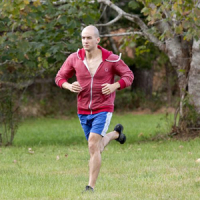Breathing: you do it more than 25,000 times on the average day. And for all sorts of reasons—overloaded lifestyles, hours spent at a desk hunched over a computer, or sitting on the couch watching TV—people tend to breathe incorrectly.

Now you might be asking, how can I possibly be breathing wrong? Generally speaking, a good breath is one where you breathe in through the nose—deeply—from the diaphragm, filling your lungs with energizing oxygen, and then forcibly ejecting the waste product carbon dioxide as your lungs deflate. Many people tend to be shallow mouth breathers, heaving their chests in and out as they take in less oxygen than they need, and getting rid of less CO2 than they should. This can lead to feeling lethargic, unfocused, and stressed out. You may not realize just how much your breathing affects your nervous system’s responses to outside stressors.
When you breathe in through your mouth, it’s a heating, energizing breath that tells your nervous system, “It’s time to go.” Something is “chasing” you and you need to get out of here. It should be pretty obvious why you don’t want to be in that state all day every day. On the flip side, when you breathe deeply through your nose, it’s like an “off” switch for your sympathetic nervous system. It activates your parasympathetic nervous system and tells your body to relax and recuperate. We don’t necessarily want that all the time either.
The key is learning different methods for controlling your nervous system through breath. Here are some general methods and specific techniques to make breathing a weapon in your wellness arsenal, rather than something that simply happens to you thousands of times each day.
Set a reminder a few times each day to simply “check in” with your breathing. Put one hand on your chest and the other on your belly and breathe for a few minutes. The focus here is to simply remind yourself to breathe in through your nose and deep into your belly. You should feel your belly rise and fall with little movement in your chest. (It helps to maintain good posture while doing this—a nice side effect.)
If you want to up the ante a little bit you can get a small pocket device call the Power Lung, a resisted breathing device that has an adjustable spring over valves controlling inhale and exhale. It looks like an oversized cigar and you simply breathe through it. This is not an oxygen- limiting device—the valve does not open until you reach and maintain a certain level of pressure, so it will actually train the muscles surrounding your lungs. You will become more efficient at moving your lungs, your oxygen utilization will increase, and you’ll actually get some cardiovascular benefits from it as well.
Another breathing technique is known as Box Breathing. It gets its name from the cycle of breathing in, holding, breathing out, and holding for the same count. To practice, get into a comfortable position and then begin inhaling deeply through your nose as your count. (Starting with a four count is usually the best.) Inhale as you count to four, and then hold as you count to four, so your lungs take full advantage of the next oxygen inside them. Then, exhale through a slightly open mouth as you count to four. Finally, with your lungs emptied out, count to four before beginning the cycle again with an inhale. This is an incredibly centering way to breathe, and it can help you prepare for anything from a tough workout to a stressful meeting.
You can also use breathing as a pick me up when you’re feeling a lethargic. There are many terms for this kind of breathing, but the general purpose is to build up heat. Whether it’s the midday lull or a long drive at night, this method will help. Even though this is an energizing method, you still want to breathe in and out through your nose. Start by breathing normally, then begin rapid in-and-out breaths through your nose. Try for 2 or 3 in-and-outs each second for about 10 seconds—that’s one set. Then, you should breathe normally until you settle back down. You can do 3 or 4 sets, increasing the time of each set as you get more comfortable with it.
For deep relaxation, try Ocean Breathing. For this method, you should be somewhere quiet and calm with your eyes closed. Focus all of your energy and effort on taking full, long inhales through your nose (filling your lungs to capacity), and then let it out through your mouth without any effort. Be very passive as the air leaves your lungs and leaves your mouth, mimicking the sounds of ocean waves ebbing and flowing.
So the next time you’re tired or stressed, take a few moments to focus on your breath. As the Buddhist monk Thich Nhat Hanh said, “Feelings come and go like clouds in the sky. Conscious breathing is my anchor.”





